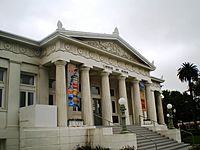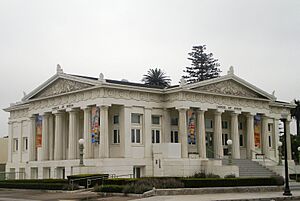Carnegie Art Museum (Oxnard, California) facts for kids

Carnegie Art Museum, September 2008
|
|
| Established | 1986 |
|---|---|
| Owner | City of Oxnard |
|
Oxnard Public Library
|
|
| Location | 424 S. C St., Oxnard, California |
| Built | 1907 |
| Architect | Franklin P. Burnham |
| Architectural style | Neo-Classical |
| NRHP reference No. | 71000210 |
| Added to NRHP | July 27, 1971 |
The Carnegie Art Museum is a cool place in Oxnard, California where you can see amazing art. It's owned by the city. This museum is in an old building that used to be the public library.
The building itself is really old and beautiful. It was built in 1907 and looks like a classic Greek temple! For many years, it was the Oxnard Public Library. Then, in 1986, it became the art museum we know today.
It's also a very important building! In 1971, it was the first building in Ventura County and the first Carnegie library in California to be added to the National Register of Historic Places. This means it's a special historical landmark.
In 2019, the city thought about closing the museum temporarily. They said it might reopen when new building projects start downtown.
Building the Carnegie Museum
Back in 1904, Oxnard's first mayor, Richard B. Haydock, wrote a letter. He asked Andrew Carnegie for money to build a library in Oxnard. Andrew Carnegie was a very rich businessman who helped build many libraries.
In 1906, Carnegie offered to give $10,000. This was a lot of money back then! He said he would donate it if Oxnard provided the land. The city also had to promise to spend at least $1,000 each year to keep the library running.
By September 1906, construction had begun. Mayor Haydock chose a special style for the building. It was called Greek Neo-Classical architecture. This style has tall, grand columns like ancient Greek temples. An architect from Los Angeles named Franklin Burnham designed the building.
Carnegie first gave $10,000 for the library. But the city decided to build a bigger, more expensive building. They wanted it to also hold the city's main offices. In July 1906, the city hired Thomas Carroll to build it for $14,000. Carnegie agreed to pay more, adding to his first gift. In the end, Carnegie gave $12,000, and the city paid $2,000. The main floor was the library, and the basement was the city hall.
The library opened on May 16, 1907. Just five years later, it was very popular. Oxnard's library had the most books checked out for a city its size in California!
In 1923, the library got bigger. A new three-story part was added to the building. This allowed the library to hold 20,000 books! The building was used as Oxnard's city hall until 1949. It continued as the Oxnard Public Library until 1963.
What Happened Next?
In March 1963, the Oxnard Public Library moved to a new place. The old building was then used by other groups. From 1963 to 1975, it housed the Oxnard Convention and Visitors Bureau. It also held the Chamber of Commerce.
The building even appeared on TV! It was used as a background for the "Dan August" television show. This show starred Burt Reynolds in the early 1970s.
In 1977, the city got a special grant of $133,000. This money was used to fix up the building. It reopened on August 16, 1980. It was then called the Carnegie Cultural Arts Center. This center was home to the Art Club of Oxnard and the Oxnard Historical Society Museum. It also had the audiovisual part of the Oxnard Public Library.
In 1986, the building officially became the Carnegie Art Museum. The City of Oxnard owns and runs it. In 2002, about 37,000 people visited the museum!
The museum has shown art from many Southern California artists. Some famous names include Michael Dvortcsak, Joyce Trieman, Frank Romero, and Gronk. The museum also has its own collection of over 1,500 art pieces. These include paintings, drawings, and photos. Most are by California artists from the 1900s. Some of these artists are Arthur Beaumont, Colin Campbell Cooper, Millard Sheets, and Leo Politi.
A Historic Landmark
In February 1971, the Ventura County Cultural Heritage Board gave the building a special title. They listed it as a heritage landmark.
Then, in July 1971, the building was added to the National Register of Historic Places. This made it the first place in Ventura County to get this important recognition.





